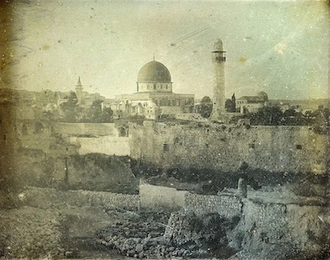Gospel in Art: Jesus sheds tears over the coming fate of Jerusalem

View of Jerusalem. Photographed by Joseph-Philibert Girault de Prangey, 1844 © The Smithsonian Museum, Washington
Source: Christian Art
Gospel of 23 November 2023
Luke 19:41-44
As Jesus drew near Jerusalem and came in sight of the city he shed tears over it and said, 'If you in your turn had only understood on this day the message of peace! But, alas, it is hidden from your eyes! Yes, a time is coming when your enemies will raise fortifications all round you, when they will encircle you and hem you in on every side; they will dash you and the children inside your walls to the ground; they will leave not one stone standing on another within you - and all because you did not recognise your opportunity when God offered it!'
Reflection on the Daguerreotype
'Jesus shed tears over Jerusalem' says Luke. Luke on the whole tends to play down the emotions of Jesus in his gospel. Yet, in today's gospel he portrays Jesus weeping over the city of Jerusalem. The tears that we shed often speak volumes about the feelings that we have for someone or something. In this morning's gospel reading Jesus is described as weeping over the city of Jerusalem. Jesus had a deep love for this city and its people. Jesus foresaw that the leaders within the city, the members of the Sanhedrin, would reject him and get him crucified. He also foresaw the Siege of Jerusalem in 70AD when the Roman army would capture the city of Jerusalem and destroy both the city and its Temple. Plenty to be sad about indeed.
Yet, the gospels suggest that the Lord will not give up on us easily. Even if we reject him or resist him, he is always there for us. Jesus' tears over us at times do not make him bitter or close his heart to us; his tears are always tears of love, a faithful love that endures in the face of human resistance.
The photograph we are looking at today by Joseph-Philibert Girault de Prangey is the very first photograph ever taken of Jerusalem, dating from 1844. The various photographs of Jerusalem which he took in that year were discovered only in the 1920s in a storeroom of his estate. Strictly speaking this isn't a photo, but rather a daguerrotype. Invented in 1839, this new, revolutionary technique of making an image required the 'daguerreotypist' to polish a sheet of silver-plated copper to a mirror finish, treat it with fumes (iodine vapour) that would make its surface light sensitive, then expose it in a camera. Each daguerreotype is a one-of-a-kind image, as the process did not allow for easy duplication. It produced a direct positive image on a polished silver surface. The resulting daguerreotypes were highly detailed, unique images with remarkable clarity and a distinctive silvery sheen. Our image indeed conveys a very atmospheric image of a city which all throughout its history has been captured, recaptured, destroyed etc… a city over which Jesus shed tears....
LINKS
Gospel in Art: https://christian.art/
Today's Reflection: https://christian.art/daily-gospel-reading/luke-19-41-44-2023/


















